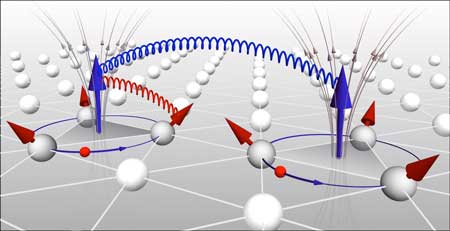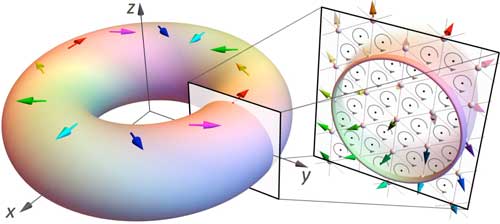| Jan 28, 2020 | |
New magnetic interaction discovered(Nanowerk News) Jülich physicists have discovered a new magnetic interaction with the aid of computer simulations (Nature Communications, "Topological–chiral magnetic interactions driven by emergent orbital magnetism"). The discovery is not only important for basic research in physics, but the scientists also expect it to be beneficial in technical innovations. |
|
| As an example, the interaction could help create special nanoscale magnetic structures. The so-called hopfions should enable the realization of neuromorphic computers, which are able to perform calculations in a highly energy-efficient manner modelled on the human brain. | |
| Interactions play a central role in physics. A well-known example is the apple that fell on Isaac Newton’s head: the cause was gravity, the mutual attraction of masses. Another example is the Coulomb interaction between charged particles, causing them to attract or repel each other. | |
 |
|
| The illustration shows the formation of topological orbital moments (large blue arrows) as a result of circular currents (thin blue arrows) flowing through groups of three atoms in a crystal lattice with a specific spin structure (red arrows). The magnetic fields (black arrows) induced by such orbital currents, mediate interactions of the TOMs with each other (blue strings) and with the magnetic moments of neighbouring atoms (red strings). (Image: Forschungszentrum Jülich) | |
| Scientists from Forschungszentrum Jülich and the Johannes Gutenberg University of Mainz discovered the new interaction in crystal lattices of the chemical compound magnesium germanide. The researchers chose this material because lattices of nanoscale magnetic nanostructures had previously been observed in it, the origin of which was unclear. | |
| Now the researchers have found a cause for this: a special triangular arrangement of atoms in the crystal lattice allows electric currents to flow without any loss of energy in tiny circles, each through the three atoms which form the tips of the triangles. A magnetic field is thus created perpendicular to the surface of each ring current, which induces a magnetic moment that the researchers call the topological orbital magnetic moment (TOM). This type of orbital moment interacts with the magnetic field generated by the ring current and also with the magnetic moments of neighbouring atoms. | |
| “We are extremely pleased about this discovery,” reports Dr. Sergii Grytsiuk from the Peter Grünberg Institute. “TOMs have extraordinary properties that make them very interesting.” Among other things, TOMs are chiral, i.e. as with human hands, there are two versions of them that cannot be transposed over each other. The researchers believe that they are particularly suitable for creating three-dimensional hopfions that have so far only been predicted, but not observed. | |
 |
|
| Representation of the magnetic structures of a doughnut-shaped hopfion, together with a hopfion cross section. Coloured arrows represent the in-plane orientations of the magnetic moments. The cross-section shows the circular currents (grey arrows) formed by the spin arrangement within each triplet. (Image: Forschungszentrum Jülich) | |
| “Hopfions can be thought of as a twisted or knotted shoelace. The more loops they contain, the higher the Hopf number,” explains Prof. Stefan Blügel, Director at the Peter Grünberg Institute and Institute for Advanced Simulation. In 2019, the physicist and his colleagues have successfully obtained the ERC Synergy Grant “3D MAGiC” from the European Research Council (ERC), a project funded with € 11.8 million, with the aim of detecting hopfions as well as other still largely unknown nanoscale magnetic structures in 3D, which possess particle-like properties and whose existence has basically so far only been predicted in theory. | |
| According to theoretical calculations, the Hopf number can assume many different values, which make them highly effective information carriers. If many such particles are collected in a material, a large store of information can be created. Their spatial extent makes it possible to cross-link them in a variety of ways via spin waves in all three spatial dimensions - a concept that cannot be realized in two dimensions. For this reason, hopfions may be suitable candidates for innovative approaches in the field of neuromorphic computing, taking inspiration from the human brain, which is also highly connected. |
| Source: Forschungszentrum Jülich | |
|
Subscribe to a free copy of one of our daily Nanowerk Newsletter Email Digests with a compilation of all of the day's news. |
